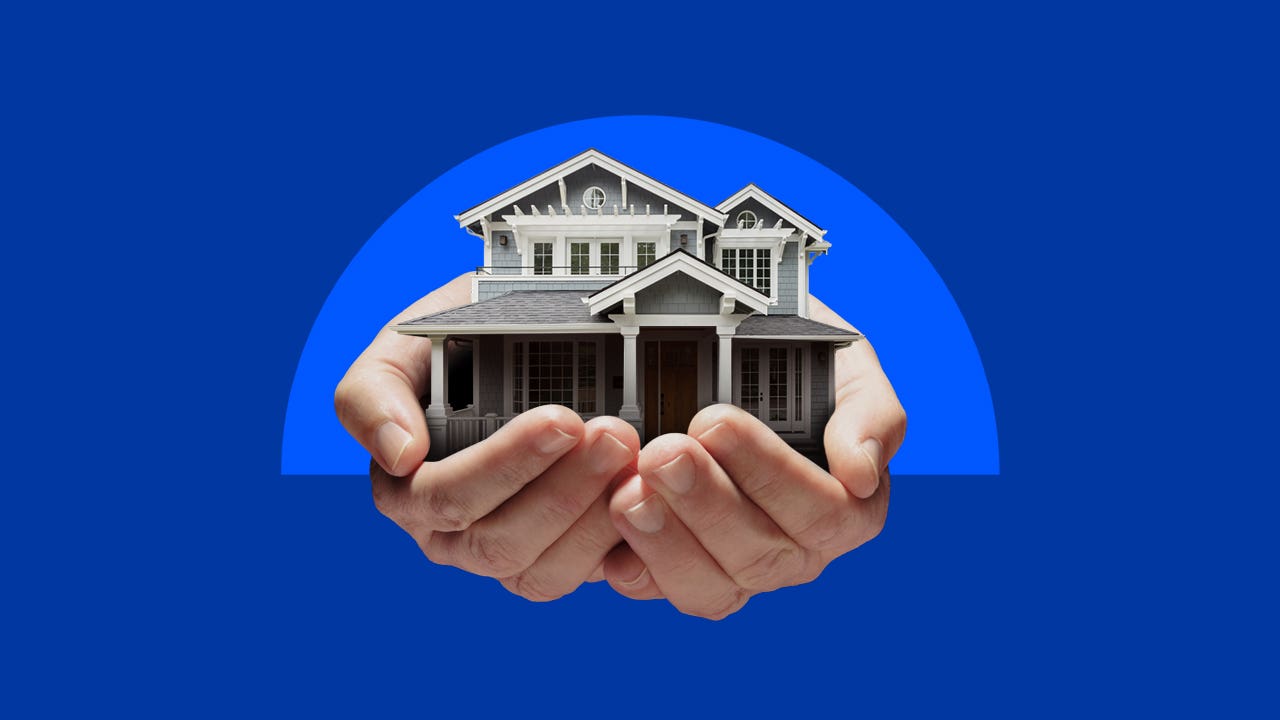What are homeowners insurance premiums and how do they work?

The Bankrate promise
At Bankrate, we strive to help you make smarter financial decisions. To help readers understand how insurance affects their finances, we have licensed insurance professionals on staff who have spent a combined 47 years in the auto, home and life insurance industries. While we adhere to strict , this post may contain references to products from our partners. Here's an explanation of . Our content is backed by Coverage.com, LLC, a licensed entity (NPN: 19966249). For more information, please see our .
Key takeaways
- Homeowners insurance premiums are the amount you pay for your home insurance policy.
- As of July 2024, the average cost of home insurance for $300,000 in dwelling coverage is $2,230 per year.
- Your home’s location, age, structural elements and the coverage levels you choose affect your home insurance premium, along with other factors.
- Florida has the highest average home insurance rates at $5,533 for $300K in dwelling coverage.
- Vermont has the cheapest average home insurance rates at $806 for $300K in dwelling coverage.
Insurance policies can come with many perks, but all are locked behind premiums. These are the rates — or costs — you pay an insurance company in return for coverage. Generally, a homeowners insurance policy only remains active so long as the associated home insurance premium is paid. Bankrate’s guide provides an in-depth explainer on what a homeowners insurance premium is and how it works.
What is a homeowners insurance premium?
A home insurance premium is the amount of money a homeowner pays for active insurance coverage for a specified amount of time called the policy term. Most insurers offer flexible payment options, with the ability to pay your homeowners insurance premiums monthly, quarterly or annually.
If you have a mortgage, your mortgage company will often pay your homeowners insurance premium through your escrow account as part of your monthly mortgage payment. Your lender then pays the premium annually to your property insurer.
How are home insurance premiums calculated?
When you purchase a new home insurance policy, the insurance company will review various rating factors to determine your premium. Some are personal to you, such as your claims history. In states that allow it, credit history may also be used. Other rating factors are related to your home like the ZIP code, the year it was built, the square footage, its general condition and its proximity to a fire station, to name a few.
Ultimately, some homes and homeowners are riskier to insure than others. For example, it is less risky for the insurance company to cover a newer home or a homeowner with a good insurance score. It’s more risky to insure a home in poor condition or a homeowner with poor credit. The more risk you and your home carry, the higher your premium will likely be.
How much is the average homeowners insurance premium?
Based on July 2024 data from Quadrant Information Services, the average annual cost of home insurance in the U.S. is $2,230 for $300,000 in dwelling coverage. However, the price of home insurance varies based on a number of factors. As mentioned, you might pay more or less than the national average based on details specific to you and your home.
One of the biggest factors that impacts your premium cost is where you live. The cost of home insurance is different in every state. In general, homeowners who live in states with a high risk of severe weather or communities with high levels of burglary and vandalism pay the most for home insurance.
Here are the most expensive states for home insurance (based on average premium):
| Most expensive states for home insurance | Average annual premium for $300,000 in dwelling coverage* |
|---|---|
| Florida | $5,533 |
| Nebraska | $5,249 |
| Oklahoma | $4,700 |
*As of July 2024
Here are the cheapest states for home insurance (based on average premium):
| Cheapest states for home insurance | Average annual premium for $300,000 in dwelling coverage* |
|---|---|
| Vermont | $806 |
| West Virginia | $952 |
| Delaware | $966 |
*As of July 2024
What is the difference between a homeowners insurance premium and a quote?
A quote is how much a home insurer estimates you’ll pay based on the information you provide during the inquiry process. A premium is the final amount that the policy will cost.
When you shop for homeowners insurance, you’ll usually provide basic information to a homeowners insurance company about your property, the types of coverage you need and the amount of coverage you need. For instance, you might specify whether you need coverage for a pool or expensive personal property. You’ll need to provide your address, since location greatly affects how much you pay for insurance. Depending on the insurance provider, you might have to answer specific questions about the home’s structure, such as the age and condition of your roof.
In return, the company will generate a homeowners insurance quote. The quote typically details what coverage your potential policy would provide and at what coverage limits. The quote should also show how much you would be expected to pay in order to keep the policy active. This is your premium. Keep in mind that premiums can vary between insurance companies, so it’s usually a good idea to shop around for insurance before purchasing a policy. Additionally, your quoted premium could change as the insurance provider finalizes your policy and verifies information.
Factors considered in your homeowners insurance premium
Below are common factors that impact homeowners insurance premiums. However, speak with your property insurer or insurance agent about your specific rating factors.
Coverage types and amounts
A main factor used to determine your homeowners insurance premium is the amount of coverage you need. Most property insurers have a valuation tool used to determine your home’s estimated rebuild cost if it were considered a total loss due to a covered peril. This coverage will appear as dwelling coverage, otherwise known as Coverage A, on your declarations page.
Many of the recommended limits for the remaining coverage types are typically calculated as a percentage of the dwelling coverage, which varies by carrier. These coverage types can often be increased independently if more coverage is needed. For example, if your policy only includes $25,000 for other structures coverage, but you have a $45,000 detached garage that you need to insure, you may be able to increase the other structures coverage in your policy.
Location
Where your home is located is another important factor used to calculate your homeowners insurance premium. Insurance companies gather data about the ZIP code where the home is located, including the risk of crime, weather events and natural disasters. The more likely it is for you to file a claim in that ZIP code, the higher the premium could be.
How close you are to the nearest fire hydrant and fire station matters as well. The closer you are, the more you can save on your homeowners insurance premium. Generally, the lower your protection class, the more favorable your premium and the more property insurers are willing to offer coverage in the area.
Being closer to coastal waters can increase your home insurance premium. The closer you are, the more likely your home is to experience damage from a hurricane or flood. If you are in a high-risk flood zone, you may be required by your insurer to buy flood insurance, which is not covered by standard home insurance and is offered as a separate policy.
Structural elements of your home
Your home’s characteristics are used to determine how much dwelling coverage is needed. There are several factors considered that make up the build of your home, including:
- Age
- Construction type
- Square footage
- Condition of the home
- Quality of the construction material used
- Any improvements or enhancements (like upgraded kitchens or bathrooms)
- Number of bathrooms
- Foundation type
Installing safety features like storm-proof windows and doors, wind-rated garage doors, home security systems, automatic sprinklers and an impact-resistant roof may lower your homeowners insurance premium.
Insurance score
An insurance score is not the same as your credit score, but it does take your credit history into consideration. Insurance scores can affect your homeowners insurance premium in most states. Insurance companies base premiums on risk, and actuarial studies have shown that people with a lower credit-based insurance score tend to file more claims with higher payouts, according to the Insurance Information Institute.
Though insurance score modeling is proprietary to home insurers generally, paying your bills on time and avoiding collections and bankruptcies will help increase your insurance score and lower your homeowners premium.
Unless you live in the following states, expect your credit-based insurance score to be a rating factor for your homeowners insurance premiums:
How homeowners insurance premiums change
Whether you make coverage changes to your insurance policy that change the premium or the insurance company itself makes a rate or coverage adjustment, it is common for homeowners insurance premiums to change each renewal period. Whether the premium increases or decreases depends on the reason for the rate change.
While many factors can impact the cost of home insurance, one of the most common reasons for a premium increase is due to inflation protection. Also known as “inflation guard,” insurance companies increase the level of coverage on your insurance policy each year to account for the rising cost of building materials, products and labor costs associated with repairing your home. Without adjusting for inflation, policyholders could be underinsured, especially if they experience a total loss and need their home completely rebuilt.
It is important to note that insurers must file (and receive approval) for broad rate increases with the Department of Insurance in each state where they operate.
Homeowners insurance premium increases
Factors that could cause an increase in your homeowners insurance premium are:
- Your insurer has filed for an average rate increase in your state.
- You renovated your home.
- You purchased new high-value items like fine jewelry.
- You filed claims.
- Crime rates increased in your ZIP code.
- Your home is located somewhere that severe weather events and other natural disasters are becoming more common or causing more damage.
- Your coverage limits were increased to keep in line with replacement costs.
- You extend your coverage limits for personal property or other items or add new endorsements to your policy.
Homeowners insurance premium decreases
Applying discounts is one of the best ways to decrease your homeowners insurance premium. You might earn a discount for adding safety or smart home features, like burglar and fire alarms. Making improvements to the home, such as adding a new roof or updating your electrical system, may also make you eligible for a discount.
A home and auto bundle is often the largest discount offered by insurers. Another way to lower your homeowners insurance premium is to increase your policy’s deductible. However, a higher deductible means a higher out-of-pocket expense if you file a claim.
Lowering your coverage limits can also reduce how much you pay for home insurance, but this adjustment should be made with caution. Reducing your limits could leave you open to financial strain if you need to file a claim. Sometimes, though, it might make sense. If you got rid of your swimming pool, you may not need as much other structures coverage. Or if you sold an expensive ring, you’d no longer need as much scheduled personal property coverage.
How to pay your homeowners insurance
When it comes to paying your home insurance premium, you have a few options:
- Pay your insurance through your escrow account.
- Pay your insurance directly to the insurance company.
Escrow account payments
One way is to pay the premium through your mortgage lender. With this option, your lender will add the cost of your insurance premium to your monthly mortgage payment and keep it in an escrow account along with funds for your property taxes. With each payment, the lender sets aside a portion of the money that goes directly to your insurance company. Depending on your lender and loan type, this may be required.
Direct to insurance company payments
The other option is to pay the insurance company directly, which works like any other bill. Depending on the insurer, you may be able to charge your premium to a credit card, mail in a check or set up an electronic funds transfer (EFT) from a checking or savings account, which is a direct deposit to the insurer. With direct premium payments, you can usually choose to pay annually, bi-annually, quarterly or monthly. Most installment plans have service fees in addition to the monthly premium.
One thing to consider is that many insurance companies will give homeowners a discount on their premium if they pay the annual cost in full, rather than through installments. Paid in full payment plans usually do not have service fees. Additionally, some companies offer discounts if you sign up for automatic payments using your bank’s routing and account number as opposed to a credit or debit card.
Frequently asked questions
-
The average home insurance premium in the U.S. is $2,230 per year or $186 per month for $300,000 in dwelling coverage. However, you might pay more or less than the average premium depending on a number of factors. Your ZIP code, insurance-based credit score (in most states) and claims history can all affect your rate, as well as the size, age and condition of your home.
-
Your premium is the amount of money you pay to keep your policy in force. But if you have to file a claim for damage to your home or personal property, you are also required to pay a deductible. A deductible is the amount of money you pay out of pocket to help cover repairs due to a claim. Anything after your deductible will be covered by your insurance company up to the policy limits when a claim is approved.
You can choose a deductible when you buy home insurance, which usually ranges from $500-$2,500, or even higher. It could also be a percentage of the dwelling amount. In states along the Atlantic and Gulf Coasts, as well as in Washington, D.C., your home policy will contain a separate deductible for windstorm coverage for named tropical cyclones. The hurricane deductible typically runs from 1 to 5 percent of your dwelling coverage.
-
Insurance professionals recommend that you get a minimum of three quotes to compare prices and coverage. When shopping for home insurance, it is easy to get quotes from different property insurers, but make sure to request identical coverage limits and deductible amounts (or as close as possible) to first ensure you are comparing carriers accurately. Also try to maximize your discount opportunities at each company, which can help you see which would provide the cheapest homeowners insurance premium for you. After this, you can add in optional coverage based on what a carrier offers to further personalize your policy and cover your needs.
Many insurers have an online quote tool that will help calculate your sample rate based on the information you submit. Numerous consumer comparison sites also allow you to obtain quotes from multiple insurers. A local agent could help you obtain quotes and other information about home insurers, too.
-
Auto and home policies usually have separate billing account numbers. While many insurance companies offer car and home insurance bundles, they might be unable to combine the account numbers to allow one payment to apply to multiple policies. However, you can usually view the billing account information for all your insurance policies under the same login. Home and auto policies issued together have a better chance of sharing an account number if the insurance company has the capability. For any account questions, check with your insurance agent for assistance.
Methodology
Bankrate utilizes Quadrant Information Services to analyze July 2024 rates for all ZIP codes and carriers in all 50 states and Washington, D.C. Quoted rates are based on married male and female homeowners with a clean claim history, good credit and the following coverage limits:
- Coverage A, Dwelling: $300,000
- Coverage B, Other Structures: $30,000
- Coverage C, Personal Property: $150,000
- Coverage D, Loss of Use: $60,000
- Coverage E, Liability: $500,000
- Coverage F, Medical Payments: $1,000
The homeowners also have a $1,000 deductible, a $500 hail deductible and a 2 percent hurricane deductible (or the next closest deductible amounts that are available) where separate deductibles apply.
These are sample rates and should be used for comparative purposes only. Your quotes will differ.
Related Articles



Mortgage insurance vs homeowners insurance: what’s the difference?
